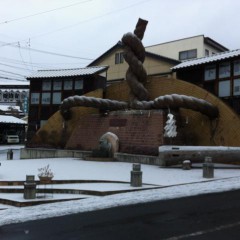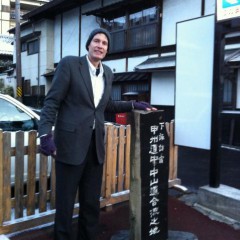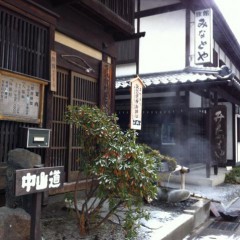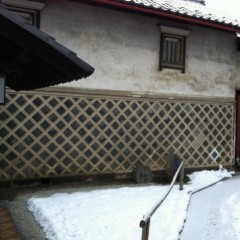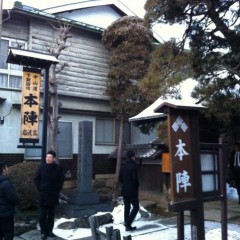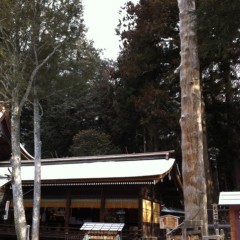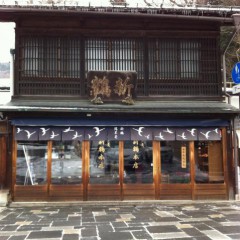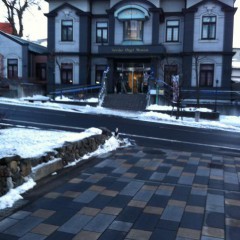八坂刀売神、
女神様の化粧水からうまれた綿の湯、
御神渡り、
等々、信州の下諏訪は神々の伝説が数えれないぐらい多い。
その神々が泊まるまちに私は初めて泊まりました。観光では何回観光来た事があったが、イマイチ下諏訪の「文化」が分からなかった。春宮・秋宮、七年に一度の御柱、一年前ぐらいから話題になった万治の石仏など部分的に知っていたが、実際に泊まってゆっくり体験しないと身に付かないところもある。
地元の諏訪の方々に案内や説明していただいてそして自ら歩いたり、見たり、食べたり、お湯に入ったりしたら下諏訪の「文化」が何となく分かってきました。
旧甲州道中と中仙道の合流点そして今まで残る街道の面影を持つ細い道を歩いて、
中仙道沿いの唯一の温泉、神の湯と言われているその下諏訪のナトリウム成分が高くて微妙に塩っぽい温泉に体を癒して、
御柱の参加者の深い想い、死より深い想いのお話を聞いて、
諏訪湖の御神渡りの話から始めて、湖はどうやって周辺に影響するか、そして耳が痛くするほどその自然の冷蔵庫の現象を実際感じて、
下諏訪の文化はこういうところからうまれているでしょう。
しかしまだまだある。オルゴールの技術、明治時代からの和菓子屋、トンネルの中の温泉銭湯、龍の口から流れる秋宮の御神湯、まだまだ沢山の文化がある。
神々が泊まるまち、泊まってみては?
The main goddess of the Shinto Suwa-sect, Yasakatomenokami, settled here.
The goddess Megumikami used the water here as her beauty water, resulting in the creation of a mineral water hotspring.
When the gods from the Upper Shrine cross Lake Suwa, they leave a path in the frozen lake surface.
Located on the northeastern bank of Lake Suwa, Nagano's largest lake, Shimo-Suwa originated as a post town on the old Nakasendo Road connecting Kyoto and Edo (old Tokyo). The Old Koshu-Dochu highway branches off from here and passes through Kofu City (neighboring Yamanashi Prefecture's capital) on an alternate route to Edo.
Besides its importance as an intersection of major Edo-era roads, Shimo-Suwa is also the home of two of the four Grand Shrines of the afore-mentioned Suwa sect of Shintoism. The other two Grand Shrines are located on the opposite side of Lake Suwa in Kami-Suwa. ('Shimo' means 'lower', 'Kami' means 'upper', pertaining to their respective positions in relation to Edo.) Hence it is a major pilgrimage destination.
More recently, Shimo-Suwa has gained distinction as a center of clockwork engineering. That heritage is made evident today by the Lake Suwa Clockwork, Science Museum 'Gishodo' with its large scale astronomical water-driven clock, and the Suwako Orgel Museum 'Somei-kan' for music boxes.
Edo era post town, the Grand Shrines, modern engineering -- that's Shimo-Suwa as seen from the outside. And that's the Shimo-Suwa I had known from my past, brief sightseeing trips there. But I'd always sensed that there was a lot more, a side that could only be understood by staying a night. So when the Nagano Ryokan Junior Association held a meeting there, I jumped at the opportunity to go and spend a night.
Seeing the Nakasendo neighborhood by lantern light at night and walking the storehouse-lined alleys in the early morning,
Enjoying the hospitality of the family-run inn and soaking in the the slightly salty waters of the onsen baths,
Hearing stories and seeing the pride of people who participate in the once every 7 years Onbashira festival, participation so death-defyingly passionate,
I feel I attained a deeper appreciation for Shimo-Suwa. But still, more remains. A 1-day watchmaking workshop, going to the public bath in the tunnel, drinking the steamy dragon water at the Akimiya shrine, and so much more.
That means I have to come back and stay again at Shimo-Suwa. Where the gods stay.
